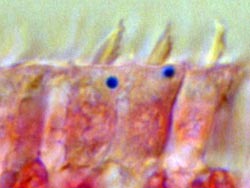Bird Navigation – Great Balls of Iron

A image showing cells from the inner ear of pigeons stained with a chemical that turns iron bright blue in colour. It highlights the balls of iron discovered by the Keays lab. Each ball of iron lies directly beneath the hairs, and there is just one per a cell. IMP<br>
Their work, published in Current Biology, reports the discovery of iron balls in sensory neurons. These cells, called hair cells, are found in the ear and are responsible for detecting sound and gravity. Remarkably, each cell has just one iron ball, and it is in the same place in every cell.
“It’s very exciting. We find these iron balls in every bird, whether it’s a pigeon or an ostrich” adds Mattias Lauwers who discovered them “but not in humans”. It is an astonishing finding, despite decades of research these conspicuous balls of iron had not been discovered.
This finding builds on previous work by the lab of David Keays who last year showed that iron-rich cells in the beak of pigeons that were believed to be the magnetic sensors, were really just blood cells. “These cells are much better candidates, because they’re definitely neurons. But we’re a long way off to understanding how magnetic sensing works – we still don’t know what these mysterious iron balls are doing.” said Dr Keays. “Who knows, perhaps they are the elusive magnetoreceptors” muses Dr Keays “only time will tell”.
The paper “An Iron-Rich Organelle in the Cuticular Plate of Avian Hair Cells” (Lauwers et al.) is published online by Current Biology on April 25, 2013.
Illustrations to be used free of charge can be downloaded from the IMP-Website: http://www.imp.ac.at/pressefoto-magnetoreceptor
About the IMP
The Research Institute of Molecular Pathology (IMP) in Vienna is a basic biomedical research institute largely sponsored by Boehringer Ingelheim. With over 200 scientists from 30 nations, the IMP is committed to scientific discovery of fundamental molecular and cellular mechanisms underlying complex biological phenomena. Research areas include cell and molecular biology, neurobiology, disease mechanisms and computational biology.
Scientific Contact
Dr David Keays
Phone: +43 (0)1 79730-3530
Mobile: +43 (0)699 19071544
e-mail: keays@imp.ac.at
Press Contact at the IMP
Dr. Heidemarie Hurtl
Communications Manager
Tel. +43 (1) 79730-3625
Mobil: +43 (0)664 8247910
e-mail: hurtl@imp.ac.at
Research Institute of Molecular Pathology
Dr. Bohr-Gasse 7
1030 Vienna
Austria
Media Contact
All latest news from the category: Life Sciences and Chemistry
Articles and reports from the Life Sciences and chemistry area deal with applied and basic research into modern biology, chemistry and human medicine.
Valuable information can be found on a range of life sciences fields including bacteriology, biochemistry, bionics, bioinformatics, biophysics, biotechnology, genetics, geobotany, human biology, marine biology, microbiology, molecular biology, cellular biology, zoology, bioinorganic chemistry, microchemistry and environmental chemistry.
Newest articles

High-energy-density aqueous battery based on halogen multi-electron transfer
Traditional non-aqueous lithium-ion batteries have a high energy density, but their safety is compromised due to the flammable organic electrolytes they utilize. Aqueous batteries use water as the solvent for…

First-ever combined heart pump and pig kidney transplant
…gives new hope to patient with terminal illness. Surgeons at NYU Langone Health performed the first-ever combined mechanical heart pump and gene-edited pig kidney transplant surgery in a 54-year-old woman…

Biophysics: Testing how well biomarkers work
LMU researchers have developed a method to determine how reliably target proteins can be labeled using super-resolution fluorescence microscopy. Modern microscopy techniques make it possible to examine the inner workings…





















